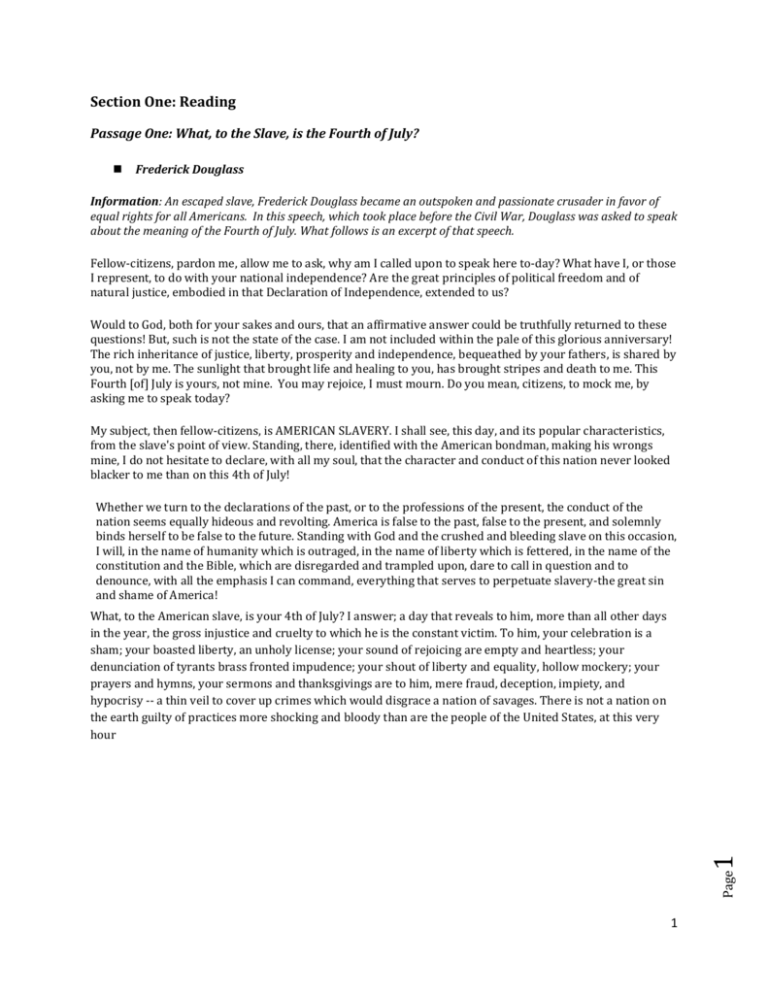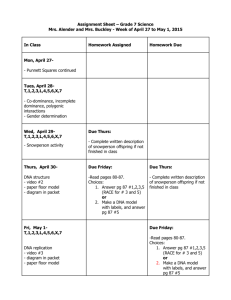Page Section One: Reading Passage One: What, to the Slave, is the
advertisement

Section One: Reading Passage One: What, to the Slave, is the Fourth of July? Frederick Douglass Information: An escaped slave, Frederick Douglass became an outspoken and passionate crusader in favor of equal rights for all Americans. In this speech, which took place before the Civil War, Douglass was asked to speak about the meaning of the Fourth of July. What follows is an excerpt of that speech. Fellow-citizens, pardon me, allow me to ask, why am I called upon to speak here to-day? What have I, or those I represent, to do with your national independence? Are the great principles of political freedom and of natural justice, embodied in that Declaration of Independence, extended to us? Would to God, both for your sakes and ours, that an affirmative answer could be truthfully returned to these questions! But, such is not the state of the case. I am not included within the pale of this glorious anniversary! The rich inheritance of justice, liberty, prosperity and independence, bequeathed by your fathers, is shared by you, not by me. The sunlight that brought life and healing to you, has brought stripes and death to me. This Fourth [of] July is yours, not mine. You may rejoice, I must mourn. Do you mean, citizens, to mock me, by asking me to speak today? My subject, then fellow-citizens, is AMERICAN SLAVERY. I shall see, this day, and its popular characteristics, from the slave's point of view. Standing, there, identified with the American bondman, making his wrongs mine, I do not hesitate to declare, with all my soul, that the character and conduct of this nation never looked blacker to me than on this 4th of July! Whether we turn to the declarations of the past, or to the professions of the present, the conduct of the nation seems equally hideous and revolting. America is false to the past, false to the present, and solemnly binds herself to be false to the future. Standing with God and the crushed and bleeding slave on this occasion, I will, in the name of humanity which is outraged, in the name of liberty which is fettered, in the name of the constitution and the Bible, which are disregarded and trampled upon, dare to call in question and to denounce, with all the emphasis I can command, everything that serves to perpetuate slavery-the great sin and shame of America! Page 1 What, to the American slave, is your 4th of July? I answer; a day that reveals to him, more than all other days in the year, the gross injustice and cruelty to which he is the constant victim. To him, your celebration is a sham; your boasted liberty, an unholy license; your sound of rejoicing are empty and heartless; your denunciation of tyrants brass fronted impudence; your shout of liberty and equality, hollow mockery; your prayers and hymns, your sermons and thanksgivings are to him, mere fraud, deception, impiety, and hypocrisy -- a thin veil to cover up crimes which would disgrace a nation of savages. There is not a nation on the earth guilty of practices more shocking and bloody than are the people of the United States, at this very hour 1 Passage Two: The Metamorphosis Information: The following passage is the opening chapter of the modern novella The Metamorphosis, by the German writer Franz Kafka. When Gregor Samsa awoke one morning from unsettling dreams, he found himself transformed in his bed into a gigantic insect. He was lying on his back, hard as armor-plate, and when he lifted his head a little he could see his dome-like brown belly divided into stiff arched segments on top of which the bed quilt could hardly keep in position and was about to slide off completely. His numerous legs, which were pitifully thin compared to the rest of his bulk, waved helplessly before his eyes. “What has happened to me?” he thought. It was no dream. His room, a regular human bedroom, only rather too small, lay quiet between the four familiar walls. Above the table on which a collection of cloth samples was unpacked and spread out – Gregor Samsa was a travelling salesman -- hung the picture which he had recently cut out of an illustrated magazine and put into a pretty gilt frame. It showed a lady, with a fur cap on and a fur stole, sitting upright and holding out to the spectator a huge fur muff into which the whole of her forearm had vanished. Gregor's eyes turned next to the window, and the overcast sky -- one could hear raindrops beating on the window gutter – completely depressed him. “What about sleeping a little longer and forgetting all this nonsense?” he thought, but that was completely impracticable, for he was used to sleeping on his right side and in his present condition he could not turn himself over. No matter how hard he threw himself onto his right side, he always rocked onto his back again. He must have tried it a hundred times, closing his eyes so as not to have to see his squirming legs, and stopped only when he began to feel a slight, dull pain in his side, which he had never felt before. Passage Three: Lincoln on Slavery Information: Abraham Lincoln often encountered arguments in favor of slavery. In this fragment, written on April 1, 1854, Lincoln works out logical oppositions to the arguments in favor of slavery. Notes in brackets have been added to clarify certain ideas. If [a random person “A”] can prove, however conclusively, that he may, of right, enslave [random person”B”] - why may not B. snatch the same argument, and prove equally, that he may enslave A? You say, “A. is white, and B. is black.” It is color, then; the lighter, having the right to enslave the darker? Take care. By this rule, you are to be slave to the first man you meet, with a fairer skin than your own. You do not mean color exactly?--You mean the whites are intellectually the superiors of the blacks, and, therefore have the right to enslave them? Take care again. By this rule, you are to be slave to the first man you meet with an intellect superior to your own. Page 2 But, say you, it is a question of interest, and, if you can make it your interest, you have the right to enslave another. Very well. And if [another person] can make it his interest, he has the right to enslave you. 2 Section Two: Finding Evidence In this section, you will read a brief nonfiction article on DNA testing for plants. You will then be answering questions that ask you to find evidence to support a claim. Fields of Fingerprints: DNA Testing for Crops DNA testing, the technique which has helped solve high-profile murder cases, may now help to solve crop crimes. Several organizations have started offering DNA testing to the North American plant-breeding and seed industry. Most often, the test will be used by plant breeders and research scientists to identify important genes. But sometimes, DNA testing will come in handy when police are trying to solve crimes that involve grain theft. While it is very difficult to tell the differences in a crop variety just by looking at the seeds, DNA fingerprinting will make it possible for police investigators or researchers to pinpoint specific plant traits and accurately identify seed varieties. Easy-to-use DNA test kits for certain crops should be on the market within the next few years. Specialized computer-based analysis programs identify the fingerprint, or specific genes carried in the seed of individual crop varieties. Producing a Print A DNA fingerprint can be called a genetic photograph of an individual, whether that individual is a plant, animal, or person. The technique of DNA fingerprinting has been developed using the science of genetics. Genetics is the study of genes, tiny units of deoxyribonucleic acid, or DNA. This chemical is located in the nucleus of every cell. An organism's DNA contains the blueprint of its characteristics --in the case of plants, that would include features like yield [the quantity or amount produced], drought resistance and starch content. Making a DNA fingerprint involves several steps as follows: 1. To obtain the DNA necessary for the test, a small sample of the plant cells is required. 2. The sample is treated with chemicals to extract DNA from the cells. 3. Enzymes (proteins which promote chemical reactions) are added to the DNA. The enzymes act like scissors. They are used to cut the DNA into fragments of various lengths. 4. The fragments are placed on a bed of gel. Next, an electrical current is applied. The current sorts the fragments by length and organizes them into a pattern. This process is similar to placing sand in a series of sieves to sort the particles by size. 5. The DNA pattern is transferred to a nylon sheet by placing the gel and the nylon next to each other. 6. A probe of radioactive DNA is introduced to the pattern on the nylon sheet. The probe, which is a short strand of DNA treated to make it radioactive, is designed to bind to specific DNA fragments. Page 3 7. Finally, X-ray film is exposed to the nylon sheet containing the radioactive probes. Dark bands, which resemble consumer product bar codes, develop at the probe sites in a pattern unique to the organism. The bands indicate the site where a probe has bound to the DNA fragments. The DNA of each individual is unique, producing a unique set of fragments. This makes each pattern of probe-binding unique. 3 Simplifying the Search DNA fingerprinting can be of use to plant breeders to simplify their work and reduce the amount of time it takes to produce crops with desirable new traits. For example, once a scientist isolates a specific gene that expresses a certain crop trait, a batch of seed is then produced which the scientist hopes carries the trait. At one time, the researcher would have to grow the crop to see if the trait is present. But now, the DNA of the seed batch can be tested to determine if the seeds contain the sought-after gene. The DNA test can also be used to identify and keep track of genes as they are isolated and transferred into crops. As well, it can become a tool to simplify the more traditional methods of selective breeding2, by identifying what are known as "markers." Since DNA fingerprints are taken from the same DNA that carries the entire genetic blueprint for the plant, pieces of DNA that are close together tend to be passed on together from one generation to the next. If one particular band of a DNA fingerprint is found to be inherited along with a useful trait, that band serves as a marker for that trait. This marker shows which offspring may carry the trait, without having to search for the specific genetic material. Note: Selective breeding: the purposeful mating of two organisms in an attempt to produce offspring with a particular trait or traits Page 4 "Field of Fingerprints: DNA Testing for Crops" from Virginia Cooperative Extension, copyright (c) 2013 by Virginia Cooperative Extension. 4





